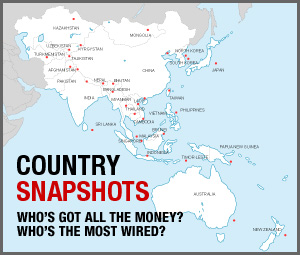
China-India-Burma 
The prospect of geo-strategic rivalry between India and China appears to be on an upward trajectory despite their increasing trade ties, with several sources of short and longer term tension evident.
First, there’s China’s expanding military and economic alliance with Pakistan. Second, is the Chinese claim that the Arunachal Pradesh region of northeast India is Southern Tibet. Third, there’s the emergence of the so-called ‘string of pearls’ strategy, with China developing closer military and economic ties with Bangladesh, Sri Lanka and Burma. And finally, there’s China’s rising dependence on Middle Eastern oil and gas that has prompted an ever larger Chinese naval presence in the Indian Ocean. And much of this Chinese expansion is prompted by powerful international and domestic economic imperatives.
China has embarked upon massive investment in various transportation projects including the construction of modern roads, rail and pipelines for both gas and petroleum as part of its ‘Go West’ strategy. This is a conscious effort to radically upgrade the transportation infrastructure in western China to further enhance regional economies and to further encourage the movement of Han peoples, even at the expense of the local populations, including specifically the Tibetans and Uyghurs. A noteworthy part of this investment strategy is the building of energy and transportation links with the major energy producers in Central Asia, specifically Kazakhstan and Turkmenistan. Although not directly related to Sino-India relations, this major geo-strategic and geo-economic move will likely aggravate tensions over time with the Russian Federation, a close military-technological ally of India.
All of this investment activity can be explained as merely China’s quest for western economic development and national energy supply diversification. However, unfortunately for India, this investment will transform the geo-military environment of South Asia and the Indian Ocean. With better roads and rail systems, China will have a dramatically enhanced capacity to project military power into the region. In fact, one might say that the product of civil engineering may be as significant as the information revolution in changing the geo-economic and geo-strategic features of the globe.
Recently, much of the public commentary surrounding China’s expansion efforts has focused on China’s increased economic and military investment in Pakistan. Noteworthy projects include the construction of a modern port at Gwadar along Pakistan’s southwest coast. The port is to be connected to a modernized road and rail net through Pakistan on to a modernized Karakoram Highway leading to western China. Military-to-military ties with Pakistan have also expanded, such as with the start of a co-production of modern fighter aircraft such as the JH-17 and contemporary main battle tanks. China’s reach and influence into Pakistan, especially through its military, may radically expand if only as a strategically defensive response to ensure that Pakistan does not degenerate into a nuclear-armed radical Islamic ‘crazy state.’
And still, over to the east, India’s attention is now turning to China’s major and sustained military and economic investment in Burma.
Peter A. Wilson is a senior analyst at the RAND Corporation. The views expressed in this essay are not those of RAND or its clients.











